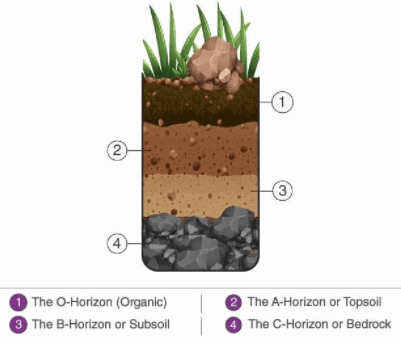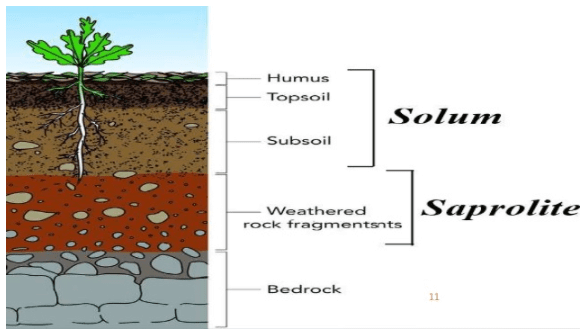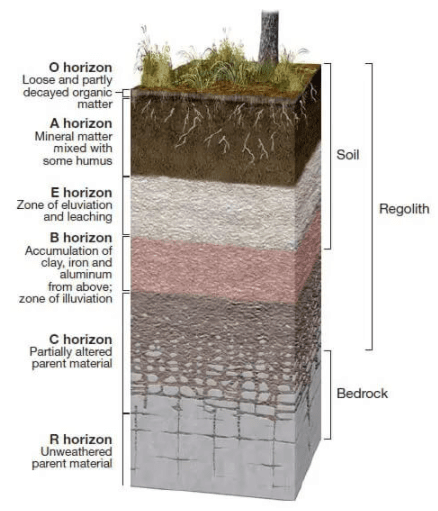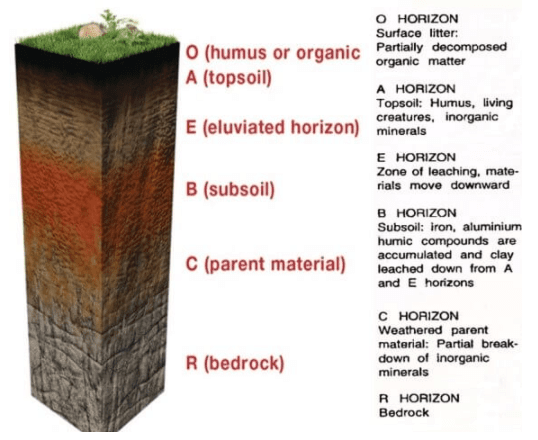Soil profile | Geography Optional for UPSC PDF Download
Introduction to Soil Profile
A soil profile refers to a vertical cross-section of various layers of soil. Typically, soil consists of three horizontal layers, namely the topsoil, subsoil, and bedrock. Each layer possesses distinct characteristics, such as texture, color, depth, and chemical composition. These layers are referred to as horizons, which are formed through internal processes like leaching or capillary action that causes the upward movement of materials and water.
- To study a soil profile, researchers often examine a hexagonal column of soil sampled from the ground. This analysis helps to better understand the unique attributes and composition of each layer within the soil profile.

- A soil horizon refers to a distinct layer of soil that is generally parallel to the surface and possesses unique physical properties that differentiate it from the layers above and below. These horizons are typically identified by their color and texture.
- The topmost layer, known as the A-horizon or topsoil, is usually dark in color due to its high humus and mineral content. The presence of humus makes the soil fertile and provides essential nutrients to plants. This layer is generally soft, porous, and capable of retaining significant amounts of water.
- Beneath the A-horizon is the B-horizon, also called the middle layer. This layer contains fewer organic materials but is richer in minerals. It is typically harder and more compact than the topsoil.
- The C-horizon is the third layer, consisting of small rock fragments and cracks. It is positioned above the parent rock material.
The soil profile is a vertical cross-section of the soil, displaying all its horizons. It extends from the soil surface down to the parent rock material. The regolith encompasses all the weathered material within the soil profile and is divided into two components: the solum and the saprolite. The solum comprises the upper horizons, representing the most weathered portion of the profile. The saprolite, on the other hand, is the least weathered part, situated directly above the solid, consolidated bedrock and beneath the regolith.

Soil Horizons
- Soil horizons are layers of soil that form due to interactions between climate, living organisms, and the land surface over time. These layers are created through the selective removal or accumulation of specific ions, colloids, and chemical compounds, which usually occurs when water seeps through the soil profile from the surface to deeper layers. Soil horizons often have distinct textures and colors, making them easily identifiable.
- There are two primary types of soil horizons: organic and mineral. Organic horizons, denoted by the capital letter O, are formed from decomposing plant and animal matter and lie above mineral horizons. The upper Oi horizon contains recognizable organic matter, such as leaves or twigs, while the lower Oa horizon consists of humus, which is organic matter that has broken down to the point of being unrecognizable.
- On the other hand, mineral horizons consist of four main layers: A, E, B, and C. Each of these layers has distinct characteristics and composition, resulting from the specific processes that occur during their formation. Overall, understanding soil horizons is essential for studying soil properties and their influence on plant growth and environmental factors.

O Horizon
- Layers dominated by organic material.
- Some O layers consist of undecomposed or partially decomposed litter (such as leaves, needles, twigs, moss, and lichens).
- They may be on top of either mineral or organic soils.
A Horizon or Surface soil
- The A Horizon, also known as surface soil, is the uppermost layer of topsoil. It is characterized by a mixture of organic and mineral matter, making it a vital component for plant life and soil organisms. This layer is rich in nutrients such as iron, aluminum, clay, and organic matter, which may sometimes dissolve and be transported within the soil.
- When there is a significant loss of these soluble elements, it results in the formation of a lighter-colored "E" horizon beneath the "A" horizon. This depletion of essential nutrients can impact the overall health and fertility of the soil. The A Horizon, therefore, plays a crucial role in sustaining plant growth and maintaining a balanced soil ecosystem.
E horizon
- The E horizon, also known as the eluviated layer, is a light-colored soil layer that has experienced significant erosion of its nutrients. This leaching process removes clay, iron, and aluminum oxides, leaving behind a concentration of more resistant minerals, such as quartz, in the form of sand and silt.
- The E horizon is typically found in older, well-developed soils and is situated between the A and B horizons.
B Horizon or Subsoil
- The B Horizon, also known as Subsoil, is a layer beneath the surface that exhibits chemical or physical changes in the original parent material. This layer is characterized by the accumulation of minerals that have been leached from the A and E horizons above it.
- As a result, elements such as iron, clay, aluminum, and organic compounds build up in this zone through a process called illuviation, which is the opposite of eluviation (the removal of these elements from the upper horizons).
C Horizon or Parent rock
- The C Horizon, also known as parent rock, is a layer in the soil profile where weathered parent material accumulates. This layer consists of sedimentary deposits, which are the remains of the original rock from which the soil is formed.
- The C Horizon contains large, unbroken rocks and is characterized by the accumulation of soluble compounds, such as inorganic minerals. This layer plays a significant role in the formation of soil and its composition, as it provides the foundation for the development of other soil layers above it.
R Horizon or Bedrock
- The R Horizon, also known as Bedrock, is the layer of partially weathered bedrock found at the base of the soil profile. This layer is distinct from the other layers above it, as it primarily consists of continuous masses of hard rock.
- Soils that have formed in situ, or in their natural position, will show strong similarities to the bedrock layer they are formed on. The R Horizon, or bedrock layer, is located beneath the other soil profile layers, typically at a depth of less than 50 feet.

Significance
- The examination of soil profiles plays a crucial role in agricultural sciences, as it helps to identify patterns of land use. By studying the different layers and horizons within a soil profile, we can effectively classify the land's capability and potential for various agricultural practices.
- This information is essential for understanding the best ways to manage and utilize land for sustainable and productive agriculture.
Conclusion
Soil profiles are essential in understanding the various layers and horizons that make up the soil, each with their distinct characteristics and composition. These profiles play a crucial role in agricultural sciences, as they help classify land capability and potential for sustainable and productive agriculture. By examining soil profiles, researchers can better manage and utilize land resources, ultimately contributing to the overall health and fertility of the soil ecosystem.Frequently Asked Questions (FAQs) of Soil Profile
What is a soil profile, and why is it important?
A soil profile is a vertical cross-section of various layers of soil, including the topsoil, subsoil, and bedrock. It is essential to understand a soil profile to determine the soil's properties, such as its fertility, texture, and chemical composition, which all influence plant growth and land use potential.
What are the different soil horizons, and how are they formed?
Soil horizons are distinct layers of soil formed due to interactions between climate, living organisms, and the land surface over time. The primary soil horizons include the O horizon (organic material), A horizon (topsoil), E horizon (eluviated layer), B horizon (subsoil), C horizon (parent rock), and R horizon (bedrock). Each layer has unique characteristics and composition, which result from specific processes occurring during their formation.
How does the A horizon (topsoil) contribute to plant growth and soil health?
The A horizon, or topsoil, is rich in nutrients, such as iron, aluminum, clay, and organic matter, which are essential for plant growth and soil organisms. This layer is also soft, porous, and capable of retaining significant amounts of water, providing a suitable environment for plant roots and microorganisms.
What is the difference between eluviation and illuviation in soil formation?
Eluviation is the process of removing soluble elements, such as clay, iron, and aluminum oxides, from the upper soil horizons (A and E) due to water seeping through the soil profile. On the other hand, illuviation is the process of accumulating these elements in the lower soil horizon (B), leading to a buildup of minerals and organic compounds.
How can studying soil profiles help improve agricultural practices?
By examining soil profiles, researchers can identify patterns of land use and classify the land's capability and potential for various agricultural practices. This information is crucial for determining the best ways to manage and utilize land for sustainable and productive agriculture, which can ultimately help improve crop yields and soil health.
|
303 videos|636 docs|252 tests
|
FAQs on Soil profile - Geography Optional for UPSC
| 1. What is a soil profile? |  |
| 2. How is a soil profile formed? |  |
| 3. What are the different horizons of a soil profile? |  |
| 4. Why is studying soil profile important? |  |
| 5. How can we determine the soil profile? |  |
















